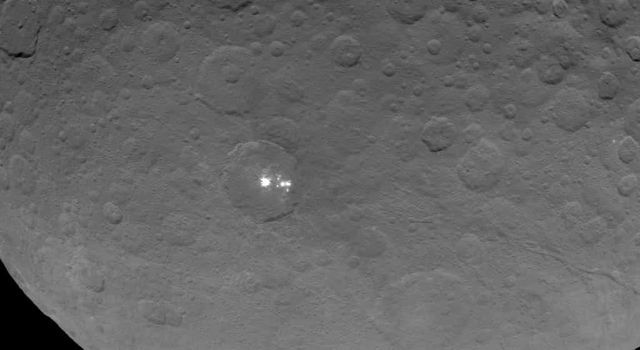News | May 20, 2015
Ceres Bright Spots Seen Closer Than Ever

› Full image and caption
NASA's Dawn mission captured a sequence of images, taken for navigation purposes, of dwarf planet Ceres on May 16, 2015. The image showcases the group of the brightest spots on Ceres, which continue to mystify scientists. It was taken from a distance of 4,500 miles (7,200 kilometers) and has a resolution of 2,250 feet (700 meters) per pixel.
"Dawn scientists can now conclude that the intense brightness of these spots is due to the reflection of sunlight by highly reflective material on the surface, possibly ice," Christopher Russell, principal investigator for the Dawn mission from the University of California, Los Angeles, said recently.
Dawn arrived at Ceres on March 6, marking the first time a spacecraft has orbited a dwarf planet. Previously, the spacecraft explored giant asteroid Vesta for 14 months from 2011 to 2012. Dawn has the distinction of being the only spacecraft to orbit two extraterrestrial targets.
The spacecraft has been using its ion propulsion system to maneuver to its second mapping orbit at Ceres, which it will reach on June 6. The spacecraft will remain at a distance of 2,700 miles (4,400 kilometers) from the dwarf planet until June 30. Afterward, it will make its way to lower orbits.
Dawn's mission is managed by NASA's Jet Propulsion Laboratory, Pasadena, California, for NASA's Science Mission Directorate in Washington. Dawn is a project of the directorate's Discovery Program, managed by NASA's Marshall Space Flight Center in Huntsville, Alabama. UCLA is responsible for overall Dawn mission science. Orbital ATK, Inc., in Dulles, Virginia, designed and built the spacecraft. The German Aerospace Center, the Max Planck Institute for Solar System Research, the Italian Space Agency and the Italian National Astrophysical Institute are international partners on the mission team. For a complete list of acknowledgements, visit:
http://dawn.jpl.nasa.gov/mission
For more information about the Dawn mission, visit:



